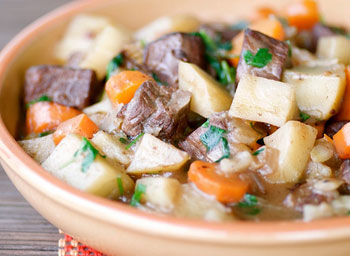 Many recipes for brown rice can require special equipment (like a rice cooker) or time consuming stovetop methods that are not always foolproof. This recipe for baked brown rice is perfect every time and eliminates the risk of poorly cooked rice.
Many recipes for brown rice can require special equipment (like a rice cooker) or time consuming stovetop methods that are not always foolproof. This recipe for baked brown rice is perfect every time and eliminates the risk of poorly cooked rice.
While white rice many be more popular, brown rice clearly is the best choice in terms of health benefits. The process of creating white rice removes almost of all of its original nutrients, and according to the World’s Healthiest Foods website, “the complete milling and polishing that converts brown rice into white rice destroys 67% of the vitamin B3, 80% of the vitamin B1, 90% of the vitamin B6, half of the manganese, half of the phosphorus, 60% of the iron, and all of the dietary fiber and essential fatty acids”.
Brown rice has been shown to help lower cholesterol, has a low glycemic rating which helps reduce insulin spikes, and is rich in anti-oxidants and high in fiber. This recipe is probably the most basic, but you can add flavor by substituting chicken or vegetable broth for the water. Once the rice is cooked, add fresh herbs like chopped parsley or basil, or sprinkle with some freshly grated parmesan cheese.

 One day when I was a little girl watching my mom make dinner, I asked her why we weren't a "meat and potatoes" family. She said, "That's because we're Italian, and we eat good food."
One day when I was a little girl watching my mom make dinner, I asked her why we weren't a "meat and potatoes" family. She said, "That's because we're Italian, and we eat good food." Leave it to my grandmother’s generation to have a delicious dessert with gelatin. A standby ingredient of the “greatest generation,” gelatin is often forgotten these days. Yet, this one ingredient provides a fantastic texture and appearance for dessert dishes. Strawberry Charlotte Russe is an “oldie but goodie,” for its name is derivative of Russian royalty and French culinary prowess.
Leave it to my grandmother’s generation to have a delicious dessert with gelatin. A standby ingredient of the “greatest generation,” gelatin is often forgotten these days. Yet, this one ingredient provides a fantastic texture and appearance for dessert dishes. Strawberry Charlotte Russe is an “oldie but goodie,” for its name is derivative of Russian royalty and French culinary prowess. What is the all-time best dunking cookie? Italian biscotti. Whether it's a glass of sweet wine or a mug of steaming coffee, biscotti's firm, crunchy texture stands up to dunking like no other cookie I know.
What is the all-time best dunking cookie? Italian biscotti. Whether it's a glass of sweet wine or a mug of steaming coffee, biscotti's firm, crunchy texture stands up to dunking like no other cookie I know. I could eat spaghetti and meatballs every night of the week. Of course my laundry bill would be astronomical. There are cleaning products for removing every possible stain including wine, coffee, ink and blood, but no one has invented a product to remove spaghetti sauce stains. Not yet anyway.
I could eat spaghetti and meatballs every night of the week. Of course my laundry bill would be astronomical. There are cleaning products for removing every possible stain including wine, coffee, ink and blood, but no one has invented a product to remove spaghetti sauce stains. Not yet anyway. 
